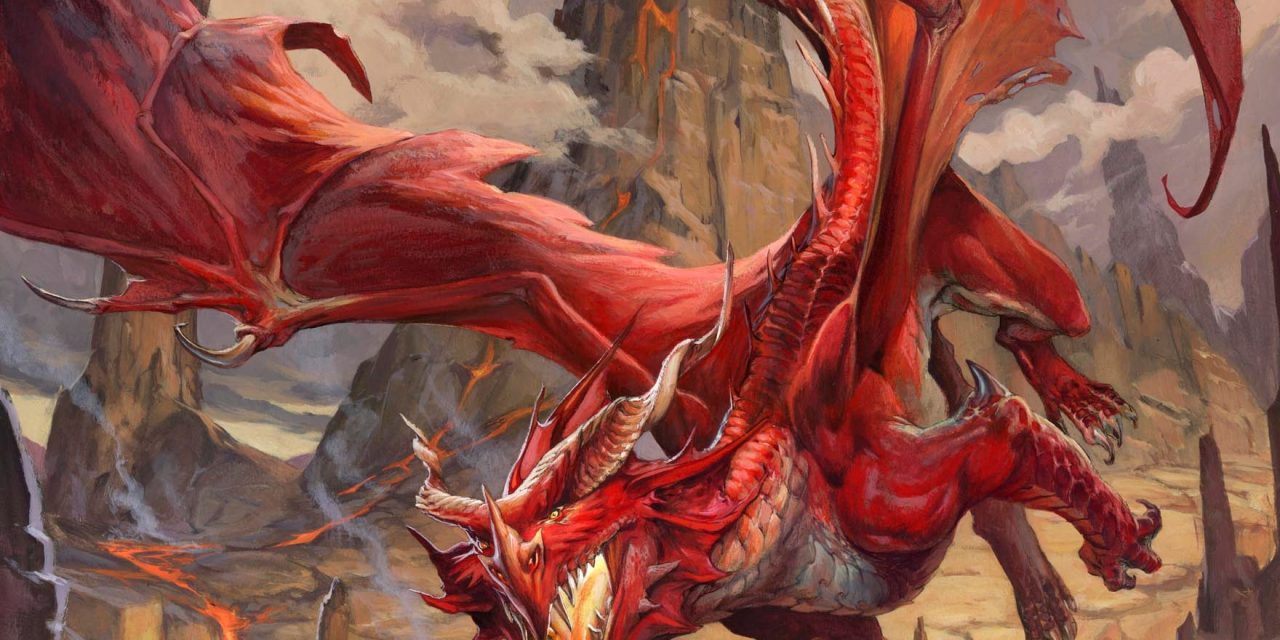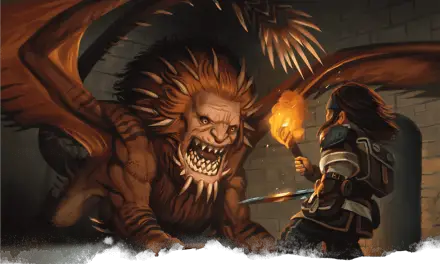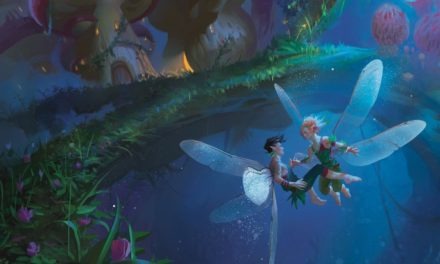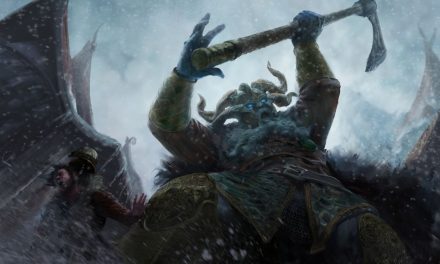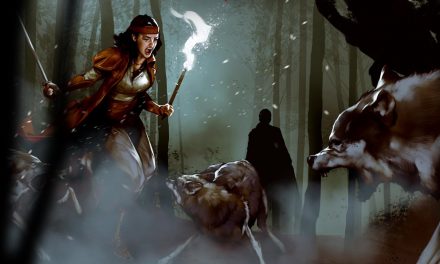Ever since I was kid, I’ve had a fascination with monsters from world mythology.
To this day, I think that that is one of my favorite things about Dungeons & Dragons. Seeing creatures in the game with origins in the mythology of cultures all over the world is just exciting!
It’s one thing to read some classic literature and imagine the story’s hero fighting the fearsome creature. But it’s another thing entirely to be that hero.
So I thought it would be fun to take a look at 10 D&D Monsters from Real World Mythology.
There’s definitely no shortage of options to choose from for this list, so I decided to limit it to one entry per culture. With so many great entries, even that limitation only made it slightly easier!
But, here we are!
So let’s check out some classic monsters from world mythology and see how accurately they’re portrayed in D&D!
Medusa
Origin: Greek
The Medusa is a snake-haired humanoid with a gaze that famously turns those who look at them to stone.
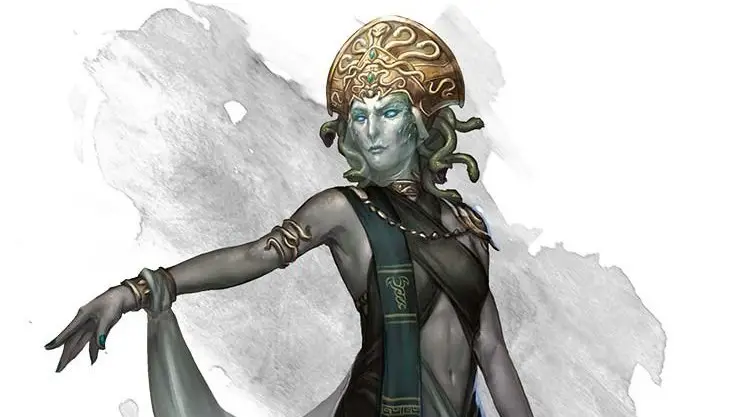
The Medusa in Greek Mythology
In Greek Mythology, Medusa was the name of one of three Gorgons. The Gorgons were monstrous female creatures with snakes for hair who could turn anyone who looked at them to stone.
Of the three Gorgon sisters, Medusa was the only one who was not immortal. She was encountered by the hero Perseus who discovered that he could use the reflection on his shield to safely look at Medusa. This enabled him to fight and subsequently behead the monster.
The Medusa in D&D 5e
In D&D 5e, Medusas are the name of the creatures who share the same traits as the Medusa of legend. Not to be confused with the Gorgon (an iron bull that also has a petrification ability), Medusas are otherwise unrelated.
Medusas are not exclusively female in D&D. Men and women alike who strike deals with powerful entities can find themselves victims to the Medusa curse. These people made their deals with the goal of preserving their youth and beauty, but, after several years of vanity, are ultimately cursed with such a hideous appearance.
Want more? Learn all about the Medusas of D&D 5e here!
Yeti
Origin: Himalayan
Also known as the “Abominable Snowman” in Western Culture, the Yeti is a massive creature that dwells in the Himalayan Mountains.
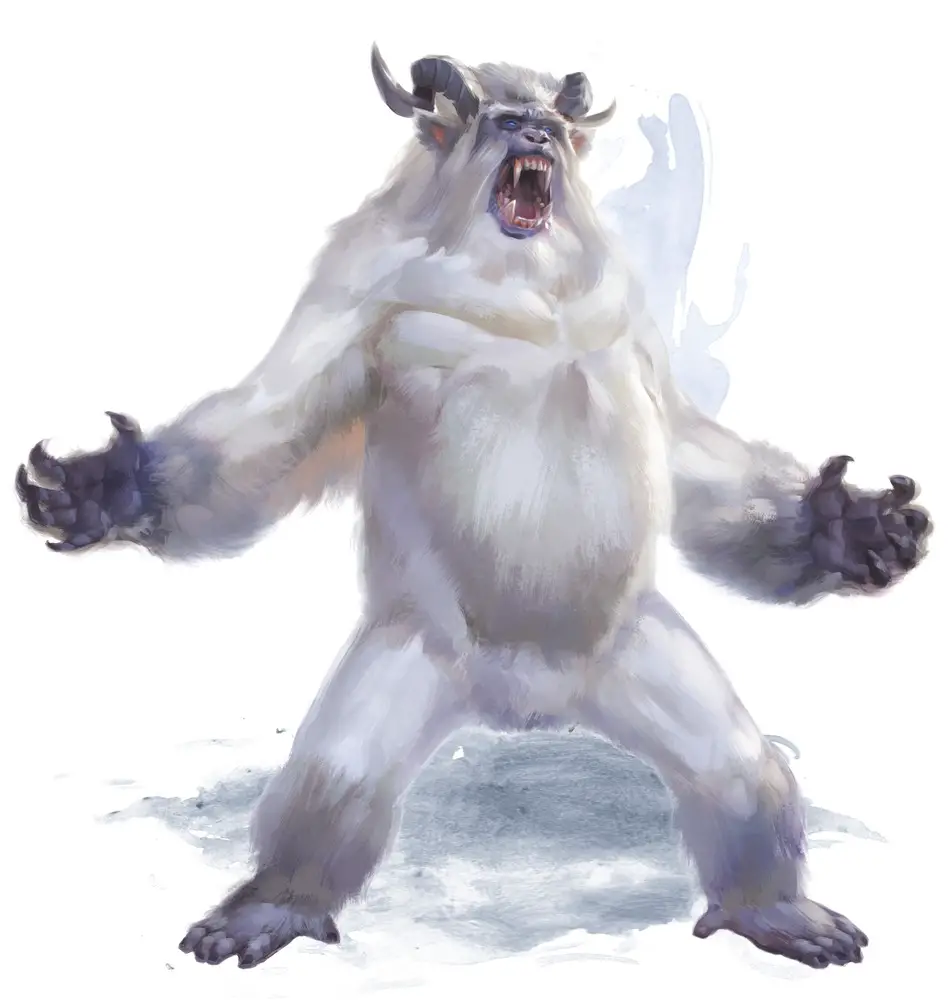
The Yeti in Himalayan Mythology
The mythology of the Yeti is just as complex and mysterious as one might imagine.
Commonly depicted as a bipedal, apelike creature, the Yeti inhabits the snowcapped mountains of the Himalayas. Largely believed to be a type of “God of the Hunt” in ancient belief systems, the Yeti’s blood is said to also have use in certain ceremonies.
To this day, there is widespread belief that the Yeti stands as some type of creature that has yet to be truly discovered. With evidence such as footprints and hair lending some credibility to this claim, the exact nature of the Yeti is still one of the world’s great mysteries.
The Yeti in D&D 5e
Yeti in D&D fit well with the real-life themes of the Yeti. These creatures are huge monstrosities who live in snowy mountain regions. Their howls fill the air during brutal blizzards, frosts, and avalanches.
Those who explore these mountainous regions may find themselves assaulted by a Yeti. These creatures are often solitary predators, but they may hunt in small groups. With a keen sense of smell, they can smell living flesh from several miles away.
Though it is not only the Yeti’s brute strength that adventurers must be wary of. These creatures possess a gaze with the ability to chill their victims to the bone. As the adventurer lies there, paralyzed and frostbitten, the Yeti moves in to strike.
Oni
Origin: Japanese
Massive ogre-like creatures who typically carry large iron clubs. The monstrous Oni are wicked with no hope of redemption and delight in causing terror in the hearts of mortals.
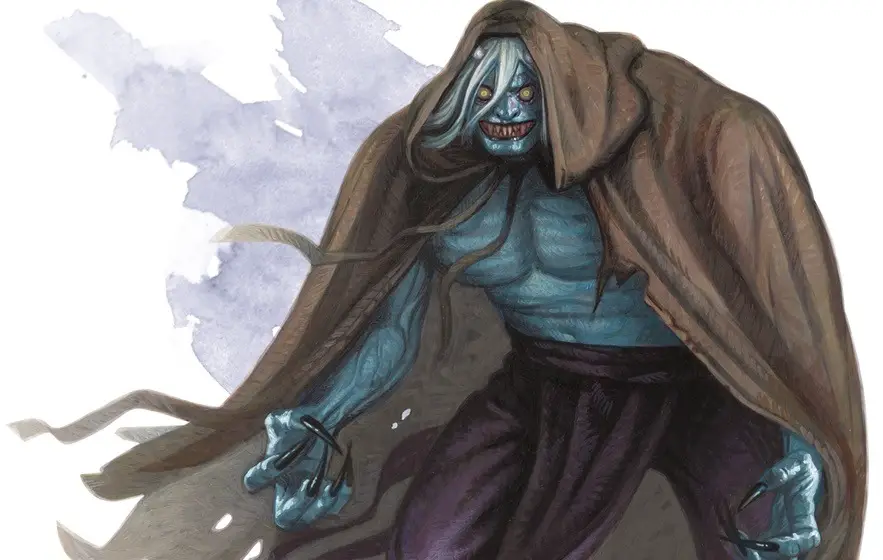
The Oni in Japanese Mythology
Oni are a type of demonic ogre found in Japanese mythology. With skin commonly depicted as red, pink, or blue, horned heads, and a sadistic love of cruelty, the Oni is a truly terrifying creature from legend.
Oni are created when a truly wicked person dies and finds themselves in one of the Buddhist hells. The person is transformed into an Oni so that they might deliver horrible and unspeakable punishments upon the doomed mortals trapped there. These punishments are primarily intended for sinners who were not quite evil enough to become an Oni themselves.
The truly wicked do not need to wait to die before becoming an Oni. While still alive, they turn into one of these horrifying creatures and set out to terrorize those around them. While other Oni remain in the afterlife to punish sinners, these inflict their cruelties on those who are still alive.
Side Note: I stumbled upon this site while doing research on the Oni. Japanese mythological monsters and ghost stories are endlessly fascinating to me and I ended up spending hours reading through the content there. If you like Japanese mythology, definitely check it out!
The Oni in D&D 5e
While the Oni in D&D 5e stay very true to the mythological representations, there are some differences between the two.
In D&D, the Oni are demonic in appearance but not necessarily in nature. They are most closely related to ogres, though even that is a distant relation. These creatures do still embody the Oni of Japanese myth’s love for cruelty and violence.
With magic meant to aid them in deceiving unsuspecting settlements that they can prey on, the Oni in D&D is just as cunning as it is cruel. While an Oni could use a large iron club, they are most commonly depicted as carrying powerful glaives that they use to skewer to their prey.
These are incredibly interesting creatures from the Monster Manual. If you’d like to read more, check out our more in-depth look at the Oni, Beware the Ogre Mage!
Fomorian
Origin: Irish
Hideous giants that dwell underwater and deep within the earth, Fomorians represent all that is dark and destructive in the world.
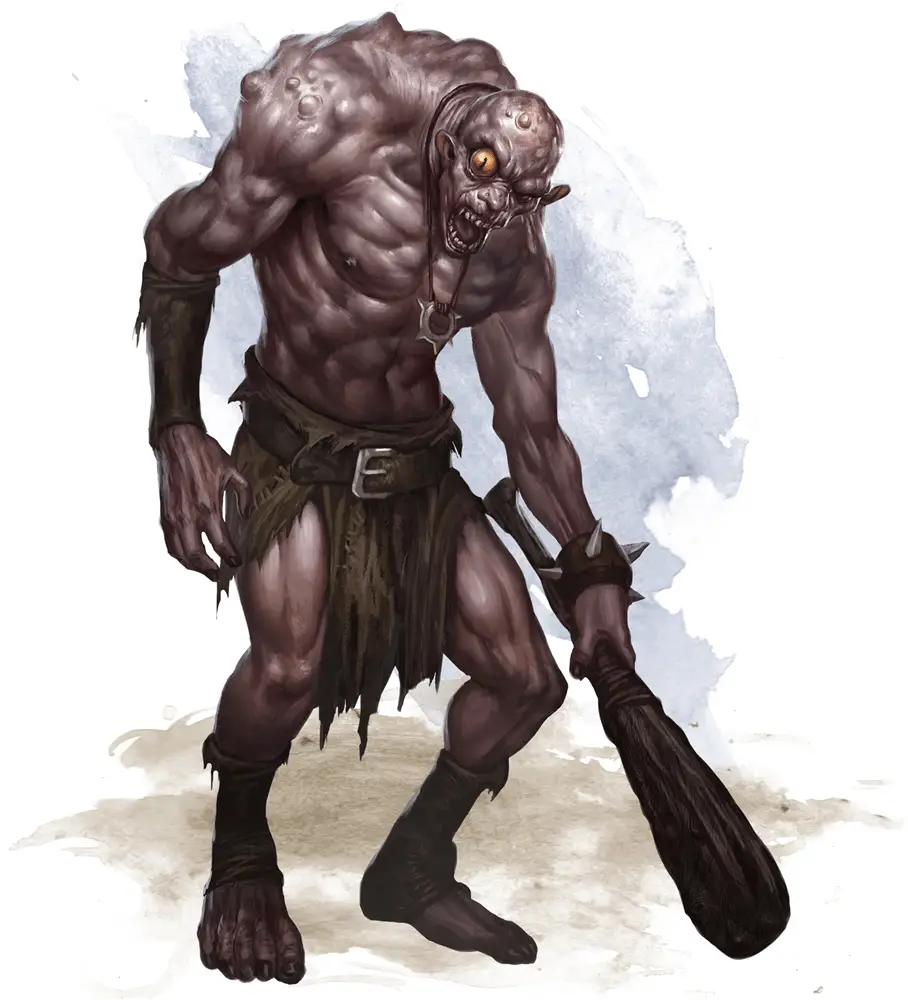
The Fomorian in Irish Mythology
The fearsome Fomorians of Irish mythology are often portrayed with several different origins. Sometimes they would crawl out from lairs beneath the sea or in dark, subterranean caverns. Other times, they were portrayed as brutal sea raiders.
Even the appearance of Fomorians in Irish myth tends to vary. Hideous Fomorians would be described as having only one eye, one arm, and one leg on a giant frame. Other descriptions described them as having human bodies with the head of a goat.
Regardless, Fomorians relished in waging war and would enslave conquered civilizations. They became known as hideous forces of destruction, blight, and terrible plagues.
The Fomorian in D&D 5e
True to legend, the Fomorians in D&D are hideous to behold. They are the most evil of all giants and it is this wicked nature that caused their terrifying appearances.
While they were once a beautiful and brilliant people, their lust for power resulted in a powerful Fey curse that turned them into the monsters that they are today. Not satisfied to suffer alone, the Fomorian can inflict this curse upon others with the use of their Evil Eye ability.
In the caverns of the Underdark, the Fomorians behave much like the Irish legends. There, they enslave others who they capture from the surface. Once these slaves no longer prove useful, they are devoured.
Troll
Origin: Norse, Scandinavian
Trolls are quite possibly one of the single greatest staples in the entire fantasy genre. With a colossal amount of interpretations and depictions, trolls never fail to stand out.
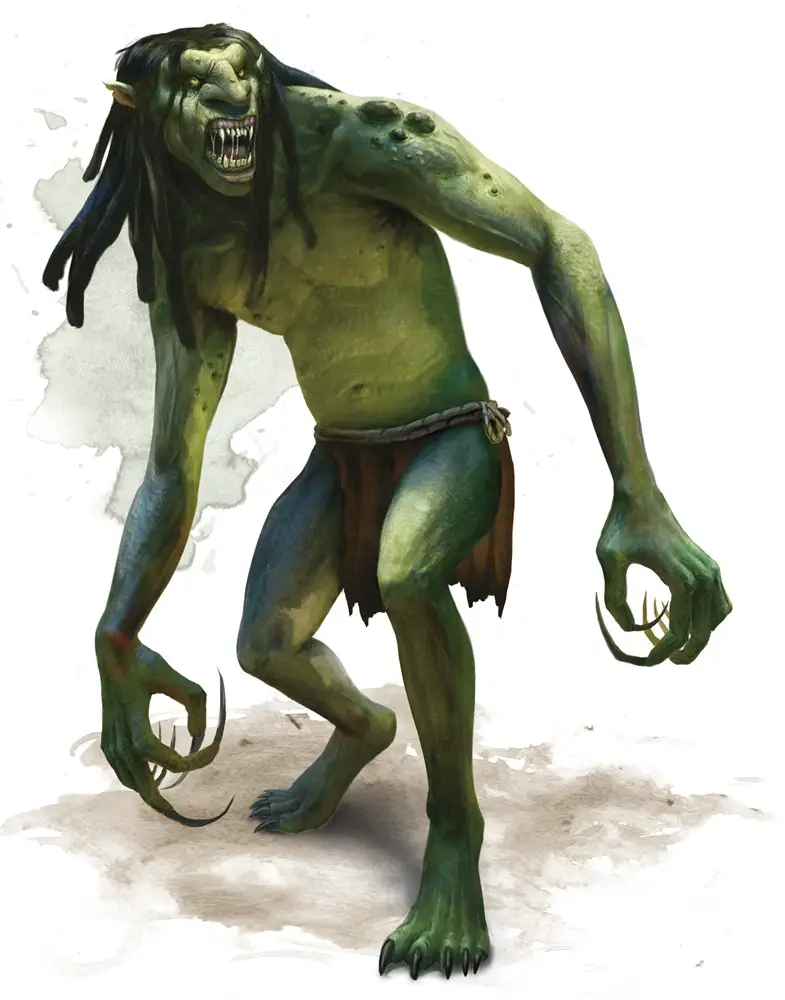
The Troll in Norse and Scandinavian Mythology
There is seemingly no end to legends of Trolls in Scandinavian mythology. What’s more, each legend seems to depict trolls slightly different from the last!
There does seem to be a clear distinction, however, between two types of trolls: the jötnar and the huldrefolk.
Generally speaking, the jötnar are most akin to the large and intimidating creatures that are typically found in fantasy settings. The huldrefolk (hidden folk) are the smaller ones that don’t care for humans but largely keep to themselves.
Because the jötnar are the ones most closely related to D&D, we’ll focus on those.
Trolls do not form societies and largely exist by pillaging. They have a strong hatred of religion, love to feast on human flesh, and are incredibly strong.
Fortunately, they are typically also pretty dim. In countless stories and legends, the protagonist is able to outsmart the vicious troll or trolls that they encounter. Whether it’s Bilbo Baggins keeping them occupied until the sun rises to turn them to stone or the Three Billy Goats Gruff baiting the hungry Troll to his doom, a clever hero knows to outwit the foul creatures!
The Troll in D&D 5e
Trolls in D&D continue the time-honored tradition of adding some unique flavor to the Troll while keeping some of its most iconic features.
Trolls in D&D are still large and brutish creatures. Anything that the Troll is able to catch becomes its food whether it’s livestock or careless adventurers. While Trolls may be found in the service of more clever or powerful entities, they still tend to do whatever they want at any given moment.
The trolls’ most iconic ability is its regeneration factor. Wounds heal quickly, limbs regrow, and any limbs that were cut off may act with a life on their own. Only acid or fire can stop the troll’s regeneration, but one should be extra careful about inviting the brute’s fury on themselves.
Because of their regeneration ability, trolls also tend to have strange mutations. Some may develop the ability to spew poison, radiate necrotic energy, or more. Mordenkainen’s Tome of Foes includes several such troll mutations in its bestiary.
Golem
Origin: Jewish
Golems are creatures that are created from material (commonly clay) and animated.
The thematic nature of golems has made them a powerful inclusion in both the fantasy and horror genres. At some times they are heroes. At others, they are virtually unstoppable forces of destruction.
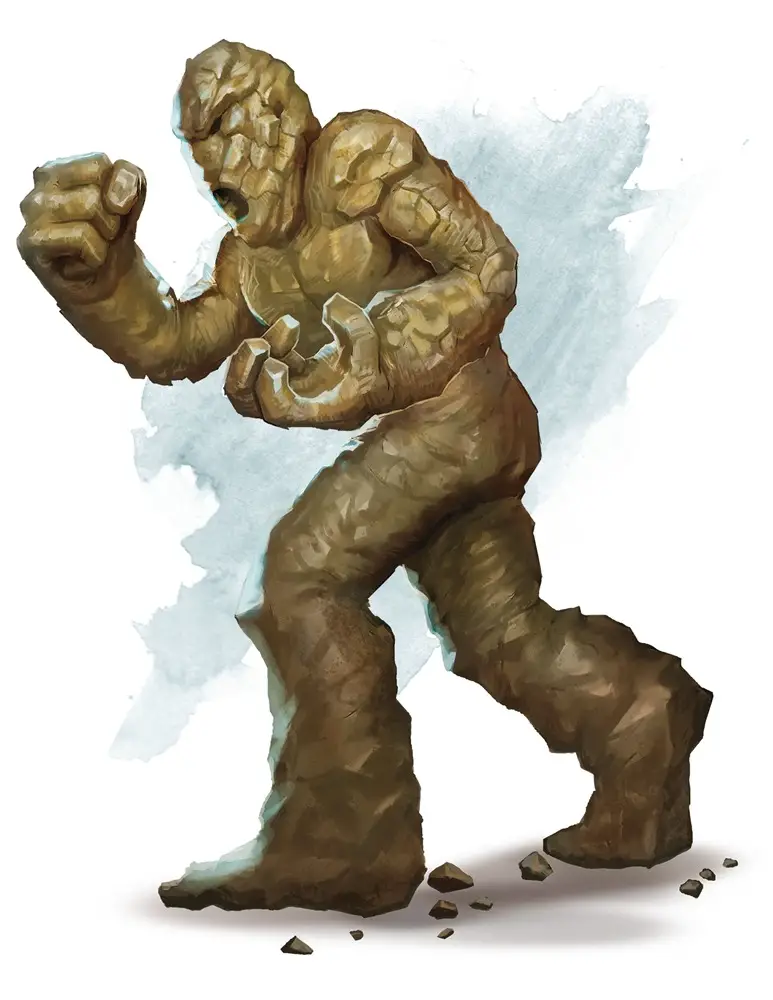
The Golem in Jewish Mythology
The most classic tale of the golem in Jewish folklore is that of Rabbi Judah Loew and the Golem of Prague.
In this legend, the golem is made of clay and animated to protect the Jewish people of Prague. With its incredible strength, the golem also serves as help for manual labor in the community.
However, the Rabbi loses control of the golem and it becomes violent. What was created to protect the people now threatened their lives and could not be controlled.
The Rabbi was forced to remove the enchantment on the golem. As a lifeless statue, the golem was then sealed away in the attic of the synagogue.
This theme has also been echoed in works like Frankenstein where such a creature is made from the flesh of the dead. Once again, the creator proves unable to control their creation which proceeds to leave a trail of destruction in its wake.
Blurring the line between life and artifice, the golem challenges our very definitions of life and meaning.
The Golem in D&D 5e
There are several types of golems in D&D. The four presented in the Monster Manual are those made of clay, flesh, stone, and iron. However, they leave a clear blueprint for those who wish to homebrew their own golems.
Golems are not able to think or act on their own. They follow the commands of those that created them to the best of their ability. Because of this, they are commonly found as guardians in forgotten temples, tombs, and other such places.
But, just like the golems of legend, they can be prone to violent outbursts. Conflicting orders or being unable to fulfill a command can cause the golem to lash out.
Similarly, Clay and Flesh Golems may go into berserk rages upon taking heavy damage. Unless their creator is there to calm them down, this can end very badly for anyone nearby!
Genie / Jinn
Origin: Arabic
What we in the West know as “Genies” have their roots as powerful spirits known as Jinn.
Of all of the entries on this list, the Jinn are probably the most confusing. There is a ton of interesting (though sometimes conflicting) folklore about the Jinn. Plus, there is also their portrayal in pop culture like “I Dream of Genie” and “Aladdin.”
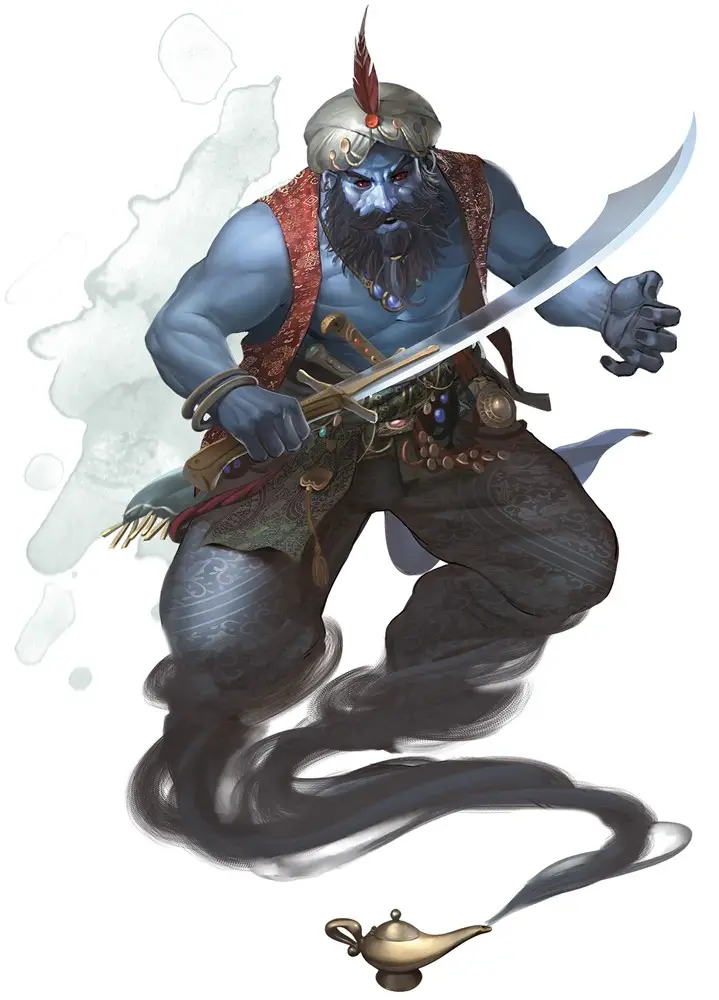
The Genie in Arabic Mythology
When researching for this article, I was surprised to see just how deep the legends of the Jinn go. Several hours (and pots of coffee) later and I feel like I’ve only scratched the surface. I’ll try to stay concise here, but I’m very curious to read in the comments if you have anything to add!
Jinn are generally depicted as shapeshifting spirits of wind and fire. While they are commonly hostile (or at least unpleasant), some may be friendly or helpful.
However, their reputation as troublemakers has made them a type of boogeyman with much in common with ghosts, demons, and fairies. Because of this, Jinn are commonly associated with possessions and diseases.
While the Jinn of legend do not live in lamps or grant wishes, they could sometimes be controlled by a talented magician.
Additionally, they might be enticed to make a deal with a human. However, Jinn enjoy few things as much as punishing someone for breaking a deal with them intentionally or otherwise! To make things more complicated, the Jinn’s unpredictable nature may lead them to trick such a person into breaking a deal.
Who knew that trolls would make it on this list twice, eh?
The Genie in D&D 5e
In D&D, Genie are formed when the soul of a creature is melded with the primordial matter of one of the Elemental Planes. Even once this happens, it will rarely result in the creation of a Genie.
As rare and noble beings, the Genie primarily stay in their palaces in the Elemental Planes. There, they keep large numbers of slaves and worshippers as a demonstration of their power.
Because they are so used to decadence and being served, Genies are very often full of themselves. This often leads to conflict with others of their kind. For all but other Genies, however, none can deny their reality-altering powers.
There are four variations of Genie found in the 5e Monster Manual. Each of these types is associated with a specific Elemental Plane.
Dao are associated with earth and detest the Djinn and Efreet. These beings are eternally greedy and malicious.
Efreet hail from the Elemental Plane of Fire. They commonly have conflict with the Djinn and Dao, but have a deep hatred of the Marid.
Djinn come from the Elemental Plane of Air and reside in grand palaces in the clouds. These are the easiest of the Genie for a mortal to get along with. While they keep their calm when dealing with Efreet and Marids, they openly hate the Dao.
Finally, the Marid represent the Elemental Plane of Water. They love telling stories with plenty of creative embellishments and are adamant about establishing hierarchies with clear titles and placements.
Marid will tolerate the Djinn and aren’t particularly fond of the Dao. However, they have a boiling hatred for the fiery Efreet.
When dealing with any of the Genie, it’s wise to play to their egos!
You can learn more about Genies in this deep-dive article all about them!
Rakshasa
Origin: Hindu
The Rakshasa of Hindu mythology is a powerful shapeshifting demon with a taste for human flesh. In their true form, Rakshasa are terrifying to behold and are often depicted with large tusks and eyes full of malice.
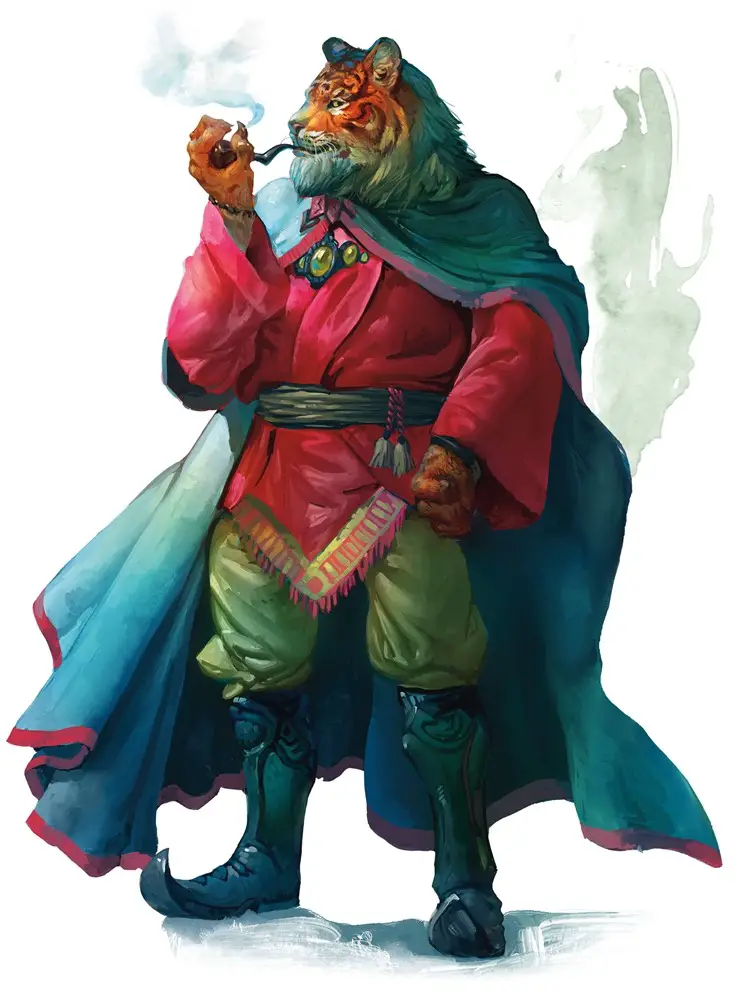
The Rakshasa in Hindu Mythology
Rakshasa of legend are said to be man-eaters who use their skills in illusion to cause destruction and mischief. Their nails are razor sharp and are often said to be venomous.
These foul creatures would infamously desecrate graves, possess humans, and disturb religious ceremonies. Attacks by Rakshasas are particularly common at night when they are the most powerful.
There are numerous versions of the Rakshasa in Hindu mythology, however.
Some depictions paint them as just being another civilization with both good and bad people. Others depict them as powerful enemies of the Gods while still others show the Rakshasas as fiends who spread chaos and fear.
The Rakshasa in D&D 5e
The Rakshasa in D&D 5e looks very different from its depictions in Hindu art.
In D&D, they resemble a mix of tiger and human. Most famously, their hands are inverted with the palm of the hand being instead where the back of the hand would be and vice versa.
The Rakshasa does keep its fiendish nature and knack for illusions. Masquerading as high-ranking figures in society, Rakshasa deceive others while selecting their intended victims with great care. Much like the mythology that they originate from, Rakshasa in D&D still love inflicting pain and eating humans.
Rakshasa are remarkably immune to all but the most powerful of spells and cannot be harmed by any non-magical weapon.
Meanwhile, the Rakshasa possesses a large amount of spells that they can innately cast. Most of these spells greatly work towards the Rakshasa’s preference for scheming and manipulating others.
When necessary, a Rakshasa may deem it necessary to strike with its claws. While this attack does not deal a particularly large amount of damage, it does put a curse on the target. Until this curse is removed, the victim is unable to rest as their dreams are plagued with horrifying dreams and images.
Couatl
Origin: Mesoamerican
The Couatl are based on the feathered serpent, Quetzalcoatl. Primarily revered by the Aztec and Nahua of Mesoamerica, the feathered serpent presided over numerous forces in the world.
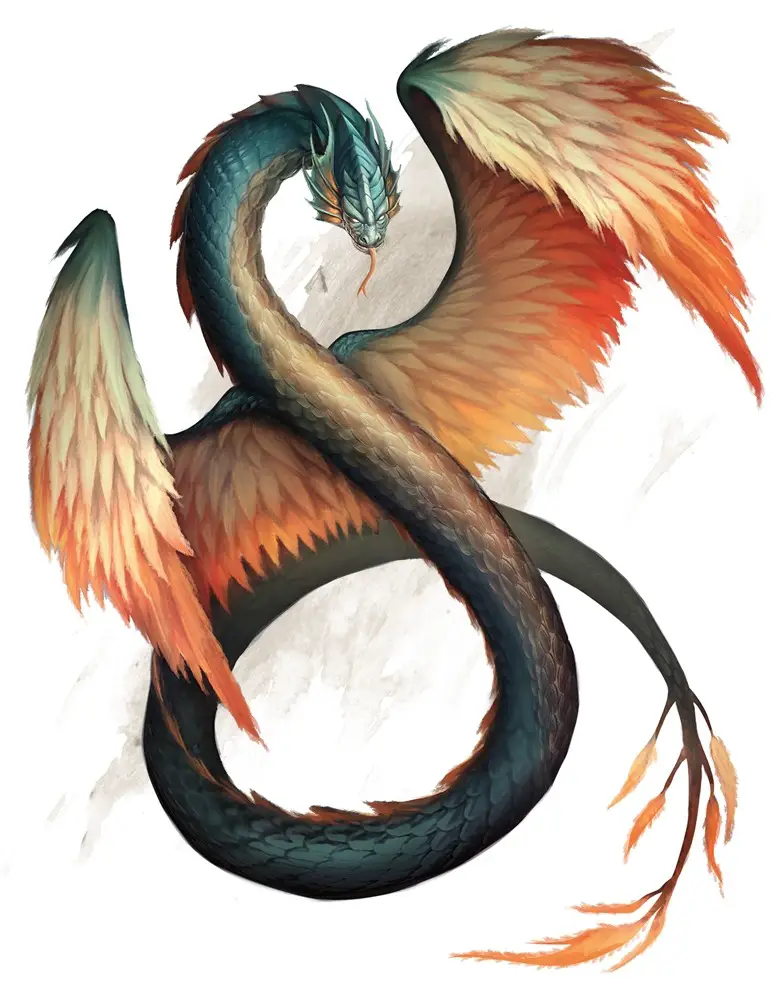
The Couatl in Mesoamerican Mythology
Quetzalcoatl was worshipped as the god of wind, air, and learning. Though it was also credited as the inventor of books and the calendar, a protector of goldsmiths, and a symbol of death and resurrection as a morning and evening star.
Though Quetzalcoatl did not rule over mankind, he was credited by the Aztecs for creating them and providing their staple crops (particularly maize.)
Quetzalcoatl is most commonly depicted as having a large snake body with brightly colored plumes of feathers. However, the clever serpent would sometimes appear as a man.
For all the good that he was credited for, Quetzalcoatl was one of the most significant figures in Mesoamerican mythology.
The Couatl in D&D 5e
While Quetzalcoatl was a single figure in Mesoamerican mythology, there are multiple Couatl in existence in D&D.
These beings share the appearance of feathered serpents and celestial nature associated with Quetzalcoatl. They are similarly intelligent, graceful, and benevolent.
Most often, Couatl serve as guardians and caretakers of ancient sites of power, prophecies yet to be fulfilled, and the heirs of those that they once watched over. Using their ability to change their form, the Couatl most often fulfill these duties out of sight or in disguise.
Most interesting about the Couatl in D&D is that they cannot lie. They may choose to only answer questions vaguely (or not at all), but they cannot lie. This is most often for the sake of protecting something or keeping a promise that they have made.
Dragon
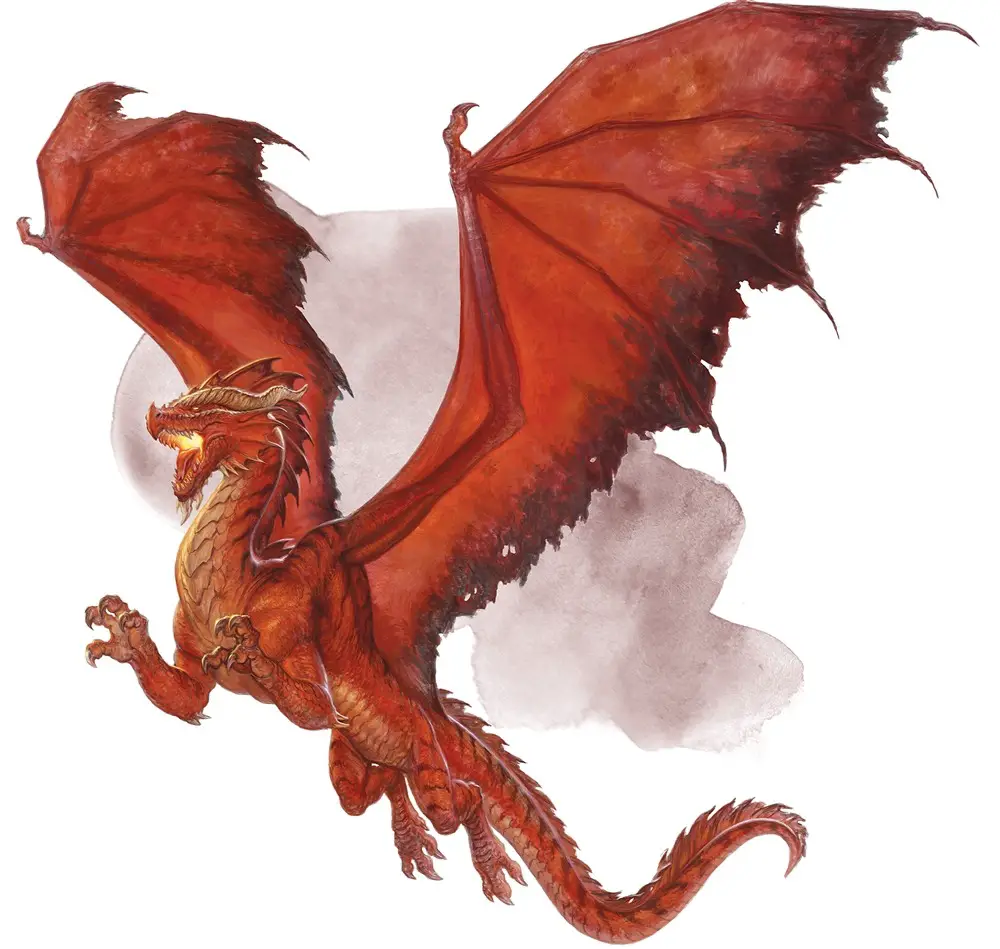
Origin: World
We couldn’t end this list without talking about the supreme granddaddy of all mythological creatures, the dragon.
With remarkably similar appearances in nearly every culture around the world, is it any wonder that the dragon is the most well-known creature of legend?
Dragons in World Mythology
What’s not to love about dragons?
These massive, serpentine beasts of legend are just cool in every sense of the word! From the classic European dragons with wings, horns, and the ability to breathe fire to the fiercely intelligent wingless dragons of Asia, they never fail to steal the show and capture the imagination.
Dragons capture everything that is epic about mythology. They lie at the heart of many of the greatest stories ever told whether grand or small.
A unique difference between the dragons of Europe and Asia stands out as a key difference between the two.
In Eastern cultures, dragons were viewed as knowledgeable creatures and deities. They commonly presided over water and had the power to command storms. Most importantly, they were often benevolent and used this power to ward off evil.
In Europe, however, dragons were viewed as evil forces of chaos and destruction. Noble knights would venture into these dragons’ dark lairs to slay the beasts. These knights of legend fought for the safety of their people, for glory, and the countless treasures in the dragon’s hoard.
What? Did you think we would forget to mention the massive piles of treasure that the dragons were said to guard?
Dragons in D&D 5e
As one would expect from a game called Dungeons & Dragons, dragons in the game’s lore carry a huge influence in the game.
Dragons in D&D are largely sorted into two types: metallic and chromatic. While both types of dragons share similar physical builds based on the European depictions, the temperament between these two types shows an interesting comparison to world mythology.
Chromatic dragons come in colors of red, blue, green, black, and white. They are the evil and destructive forces from European legends. These dragons’ cunning is matched only by their strength and cruelty.
Metallic dragons, on the other hand, are traditionally good. With shining builds of bronze, brass, silver, gold, and copper, it’s difficult to deny their nobility.
Metallic dragons view themselves as but one of many races in the world and use their strength to preserve and protect others. While their physiology may not be like that of dragons in Asian mythology, their temperament has strong similarities.
Conclusion – 10 D&D Monsters from Real World Mythology
Wow, this article ended up being way longer than I expected.
But it was a ton of fun researching the origins of these iconic creatures!
There’s something particularly exciting about facing creatures in D&D that have strong ties to real world mythology. While some creatures like Medusas or Genie are well-known myths of legend, D&D also serves a type of educational purpose as well.
After all, fighting Rakshasas and Fomorians may very well prompt players to learn about the cultures that these beings originate from.
So what did you think of this list?
Were there any that you would have preferred to see make the list?
Writing about the monsters and lore in D&D has quickly become my favorite part about writing this blog, so I’m always very appreciative of suggestions for future articles!
Let me know in the comments!

